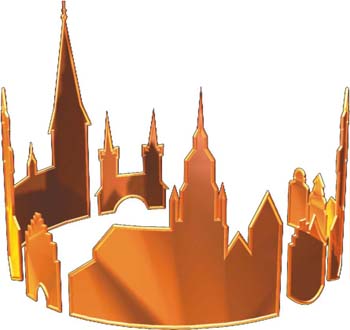
Stargard Pomerania's Jewel
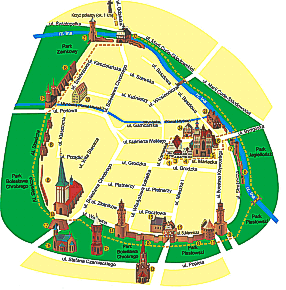 1500 Years Of Stargard
1500 Years Of Stargard
6th cent. a golden necklaces - found in Stargard Mroczeń
9th -10th cent. - settlement in Stargard Osetno
9th -10th cent. stronghold, borough and harbour on the Ina-river's island
1124 town's name written for the first time as 'castro Zitarigroda' (the description of 1st mission of bishop Otton)
1140 Stargard becomes the castellan's castle (papal edict of Innocent II)
1243 (1253) town's foundation on Magdeburg law
1292 conferment of Lubeck roghts more lucrative for Stargard; the beginning of St Mary's church's erection
1295 prince's castellany's abolition the erection of town walls
14th cent. Stargard one of the biggest grain exporters in this part of Pomerania (1367 confirmation of Hanse participation)
1380 rebuilding of St Mary's church (into a basilica church)
1409 Stargard becomes a republic town (the last resort of criminal jurisdiction)
15th cent. Stargard (more than 5 thousands citizens) among 15 biggest towns on the southern Baltic coast (from Novograd to Lubeck)
1454-1464 unsolved trade war with Szczecin
16th cent. further town's prosperity, shaken by the fire in 1584
1625-1626 the great epidemic of bubonic plague (according to some sources up to 6 thousands victims)
1630 the Swedes in Stargard (the 30-year war in Pomerania; independence lost for the benefit of Brandenburgien)
1633 the erection of Collegium Groeninganum, from 1714 academic college
1635 all town's buildings (around one thousand) destroyed in fire only 18 houses and St John's church were left
1668 Stargard the capital of Brandenburgien Pomerania, renovation of the town
1723 mail coach put into service
1772 the first theatre (Town Hall's Theatre) in the town's history
1782 the first manufacture (after a short time the town becomes the important weavers' centre
1825 Stargard the seat of local district authority (from 1901 also of town district)
1846 railway connection with Szczecin and Berlin (1848 with Poznań, 1856 with Koszalin, 1883 with Pyrzyce, 1895 with Piła and 1895-96 the narrowgauged railway connection with Ińsko and Dobra); Stargard the biggest railway junction in Pomerania
1856 the gas-plant put into service
1859 the estabilishment of railways workshops, in the beginning of 20th cent. the second industrial work in Pomerania
1869 invention and patenting of pitch paper (Meisner fabric)
1879 The erection of modern town hospital (Movius Hospital)
1896-97 waterworks, canalization, and water plant put into service
1899 the estabilishment of power plant
1901-11 the general, profesional renovation of St Mary's church (H.Deneke)
1939 Stargard has around 40 thousands inhabitants
05.03.1945 the 1st Belarus Front conquests Stargard; destruction of the town around 70%, of the Old Town almost 100%
1960 the beginning of the Old Town's rebuilding
1978 first electrical train in Stargard
Dear Friend, welcome to Stargard Pomerania's Jewel
You are in the right place, because our town can be named as an example of Pomerania's
history. The amount of historical buildings and their class puts Stargard in the first
among the Middle and Western Pomerania's historical towns. The most interesting
place is the area of the old medieval town, which gave the beginning to today's
Stargard with its 75000 inhabitants. To help you know the town better, we marked
out the Old Town Path called "Stargard Pomerania's Jewel". This path enables you to
visit the most important historical buildings, which illustrate the special teatures
of Ina-river town.
The path leads mostly through 3 km long park from 18th 19th cent.
Park is situated along the great town walls, bastions, moats, gates, turrets and
rotundas, that can be compared with the famous ones in Cracow. High church towers
(including St Johan's the third highest church tower in Poland), the biggest
turrets in Poland, and one gate of two in Europe stretched over the river's bed.
But the greatest pleasure would be to visit the monumental St Mary's collegiate
church the most beautiful, gothic, brick church in Poland.
The "Stargard Pomerania's Jewel" Path makes a circle, thus you can, dear Friend,
begin in every place suitable for you. The whole path takes about two hours,
although if you want to visit museums, climb up to the view-point and in the
end rest in one of the picturesque parks you will definitely need more time.
We assure you it will not be wasted.
A FORMIDABLE POMERANIAN FORTRESS
1. The Old Town Hall - the medieval town's heart.
It was built during Stargard's foundation. Around it are the most important town
buildings and rich citizens' houses. Up to the last century markets.
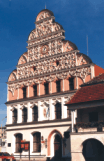 2. The Town Hall - the biggest medieval town hall in Pomerania.
Built around 1250, rebuilt in 14th cent. Today's late-gothic
fasade dates from the second half of 16th cent. Gables decorated
with ingenious net-tracery. The great fire in 1635 destroyed the Town Hall
together with town's archives. It was rebuilt but destroyed again in 1945.
Rebuilt in 1957-61.
2. The Town Hall - the biggest medieval town hall in Pomerania.
Built around 1250, rebuilt in 14th cent. Today's late-gothic
fasade dates from the second half of 16th cent. Gables decorated
with ingenious net-tracery. The great fire in 1635 destroyed the Town Hall
together with town's archives. It was rebuilt but destroyed again in 1945.
Rebuilt in 1957-61.
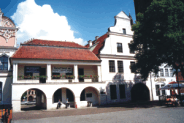 3. The Guardhouse - from around year 1720 in baroque style.
It was the seat of town's fire brigade. Probably the first in Pomerania.
Nowadays the Museum.
3. The Guardhouse - from around year 1720 in baroque style.
It was the seat of town's fire brigade. Probably the first in Pomerania.
Nowadays the Museum.
4. Baroque tenement-houses around the Old Town Market.
No 3 17th cent. (New Stock Exchange ?), rebuilt after fire in 1635.
No 4 built in the same period of time (instead of a church yard).
After destruction in 1945 both were rebuilt in baroque style. In No 4 - seat
of Tourist Information Centre, led by Stargard's Friedens Society.
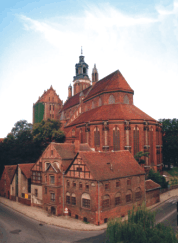 5. St. Mary's Queen of the World collegiate church - the most precious
West and Middle Pomerania's monument, enlisted in the most beautiful gothic brick church in Poland. Inspiration for tens of
of buildings in at least three countries. Began in 1292, present form from
14th - 15th cent. Two-tower basilica church with chapels
around the choir. A typical Hanseatic town cathedral, represented only in the biggest
towns around Baltic Sea. Delicate, ceramic elevation ornaments; original tower
interior decorations so-called Stargard blend, unique triforium gallery
in presbytery they all make for the higher rank of the church. The interior,
after many destructions, is poorer: the altar from 1663, wall-paintings
(15th - 18th cent.), epitaphs, altars, framed chapels'
entries (18th cent.) and stained glass (19th
- 20th cent.).
5. St. Mary's Queen of the World collegiate church - the most precious
West and Middle Pomerania's monument, enlisted in the most beautiful gothic brick church in Poland. Inspiration for tens of
of buildings in at least three countries. Began in 1292, present form from
14th - 15th cent. Two-tower basilica church with chapels
around the choir. A typical Hanseatic town cathedral, represented only in the biggest
towns around Baltic Sea. Delicate, ceramic elevation ornaments; original tower
interior decorations so-called Stargard blend, unique triforium gallery
in presbytery they all make for the higher rank of the church. The interior,
after many destructions, is poorer: the altar from 1663, wall-paintings
(15th - 18th cent.), epitaphs, altars, framed chapels'
entries (18th cent.) and stained glass (19th
- 20th cent.).
6. The Presbytery Complex - the tree oldest buildings are from
14th, 16th and 19th cent..
In 15th cent. the school, later: priests' and organists' flats,
museums, deaconship, parish offices.
7. The Captives' Turret - 15th cent., the most simple of Stargard turrets
(cylindrical form), 13 m high, crenelles.
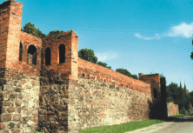 8. Town Walls - the basic element of Stargard fortifications,
one of the most fortified towns in Pomerania. From the original 2260 m long
wall-ring (the area it covered was two times larger than the Old Town in Poznań)
only 1040 m survived. Up to 8 m high walls. Its defensive efficiency
was improved by: watch, towers, half-turrets (45), turrets (9), gates with
porches (4), basteis (4) and embankments with rotundas (mounded in 16th
cent., heightened in 17th cent.), separated from the walls by the
inner moat and surrounded by the outer one.
8. Town Walls - the basic element of Stargard fortifications,
one of the most fortified towns in Pomerania. From the original 2260 m long
wall-ring (the area it covered was two times larger than the Old Town in Poznań)
only 1040 m survived. Up to 8 m high walls. Its defensive efficiency
was improved by: watch, towers, half-turrets (45), turrets (9), gates with
porches (4), basteis (4) and embankments with rotundas (mounded in 16th
cent., heightened in 17th cent.), separated from the walls by the
inner moat and surrounded by the outer one.
Walking down Aleja Słowicza along the old embankments you can see (marked on the map):
an amphitheatre and a neo-Renaissance villa (1926) belonging to the Karows
a meritorious miller family. Today the seat of Youth Social and Recreation Club.
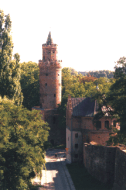 9. The Weavers' Turret
(The Ice Turret, The Clothiers' Tower)
- 15th cent., eight storeys, 31 m high.
Apart from the Red Sea Turret is the most splendid Polish turret.
9. The Weavers' Turret
(The Ice Turret, The Clothiers' Tower)
- 15th cent., eight storeys, 31 m high.
Apart from the Red Sea Turret is the most splendid Polish turret.
In prospect of Sukiennicza street the beautiful view of town fortifications
(one of the few in Poland)
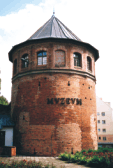 10. The Rotunda - beginning of 16th cent.
A piece of fortifications sticking out from the walls, adapted to fire-arms
evolution. In 19th cent. Used as habitable room. Today the
Museum department.
10. The Rotunda - beginning of 16th cent.
A piece of fortifications sticking out from the walls, adapted to fire-arms
evolution. In 19th cent. Used as habitable room. Today the
Museum department.
11. The Pyritz Gate - 13th - 15th cent.,
one of the most beautiful in Pomerania, similar in form to today's non-existing
St Johan Gate. In front of it was a crossing between a route from Skalin and
from Pyritz (called up to 19th cent. The Polish Way).
12. The Holy Ghost's church - built between 1874 - 77.
Neo-gothic hall building with inner gallery, slender 50 m high tower.
The fourth church built in this place.
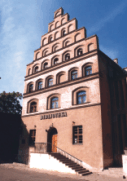 13. Kletzin's House (Rohlender's House)
- first half of 16th cent. The seat of a wealthy trader.
Richly decorated stone and brick gable. Building rebuilt after destruction in 1945.
The seat of town's Public Library.
13. Kletzin's House (Rohlender's House)
- first half of 16th cent. The seat of a wealthy trader.
Richly decorated stone and brick gable. Building rebuilt after destruction in 1945.
The seat of town's Public Library.
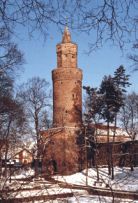 14. The Red Sea Turret - the biggest town turret in Poland,
34 m high. Seven stories, three defensive galleries. The passage was
created in 1869. The name comes from red (bog iron stone) colour of swamps
in front of the turret, or according to the legend from the sea of blood once spilled
there. In high season a view-point.
14. The Red Sea Turret - the biggest town turret in Poland,
34 m high. Seven stories, three defensive galleries. The passage was
created in 1869. The name comes from red (bog iron stone) colour of swamps
in front of the turret, or according to the legend from the sea of blood once spilled
there. In high season a view-point.
15. The Pressure Tower - 65 m high neo-gothic building
from 1896 - 97. Richly decorated elevation. Rare technical monument
from 19th cent.
16. St Peter's and St Paul's church - from 1890 - 91.
Neo-gothic, on Greek cross location (33 m high tower). One of five
Stargard churches build in this period. Originally called Christ's church
and belonged to the Reformed Church. From 1953 belongs to the Orthodox Church.
17. Neo-gothic tunnel - from 19th cent. Nearby was once
a porch of St John's Gate.
Near the tunnel there is the biggest Stargard bastion called "the Pot", which
except from its defensive roll was used 16th - 17th
cent. by bell-founders.
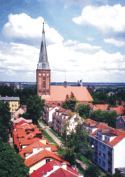 18. St John's church - Knights of St John of Jerusalem Church,
three naves, in late gothic style. Began in 13th cent., finished
in 15th. Tower has got so-called Stargard blend. 1892 - 1893
heightening of tower's dome to 99 m. In choir gallery unique crystal
chapels' ceiling.
18. St John's church - Knights of St John of Jerusalem Church,
three naves, in late gothic style. Began in 13th cent., finished
in 15th. Tower has got so-called Stargard blend. 1892 - 1893
heightening of tower's dome to 99 m. In choir gallery unique crystal
chapels' ceiling.
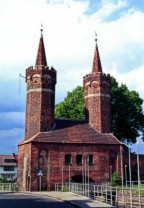 19. The Mill Gate (also: The Harbour Gate or The Water Gate)
- from 15th cent., unique in Europe. In medieval times watch lowered
a portcyllis into the river for the night. It secured Stargard harbour, which
was situated behind the fortification (an exception in this area), from
intruders. Both towers have got socalled Stargard blend motive (the same as in
St Mary's church).
19. The Mill Gate (also: The Harbour Gate or The Water Gate)
- from 15th cent., unique in Europe. In medieval times watch lowered
a portcyllis into the river for the night. It secured Stargard harbour, which
was situated behind the fortification (an exception in this area), from
intruders. Both towers have got socalled Stargard blend motive (the same as in
St Mary's church).
We are entering an island now. Here was the beginning of Stargard's township.
20. The Granary - 16th cent. In 18th cent.
there was a king's salt warehouse, later a granary again. Rebuilt as the only
one of four after 1945.
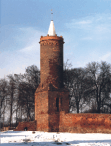 21. The White Head Turret - from the first half of 15th
cent., 30 m high. Six storeys with prison dungeon. The entrance is levelled
with the old wooden porch, that used to be there. The name comes from the colour
of turret's top or according to the legend from women defending the turret
(in old Polish woman could be also called białogłowa "the white-head").
21. The White Head Turret - from the first half of 15th
cent., 30 m high. Six storeys with prison dungeon. The entrance is levelled
with the old wooden porch, that used to be there. The name comes from the colour
of turret's top or according to the legend from women defending the turret
(in old Polish woman could be also called białogłowa "the white-head").
Behind the turret towards Ina-river was the castellan's seat, destroyed in 1295.
The area was heighten afterwards, by strengthening the fortification with another
artillery bastion.
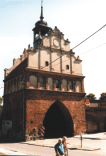 22. The Wall Gate - from the first half of 15th
cent. Renaissance gables and avebell (1615th and - 1715th
cent.). On the south wall latrine oriel. Before demolition in 1780 a porch with
barbacane on the other side of Ina-river. Today the Mill Gate is the seat of
Stargard's Society of Fine art. Lovers.
22. The Wall Gate - from the first half of 15th
cent. Renaissance gables and avebell (1615th and - 1715th
cent.). On the south wall latrine oriel. Before demolition in 1780 a porch with
barbacane on the other side of Ina-river. Today the Mill Gate is the seat of
Stargard's Society of Fine art. Lovers.
After passing the bridge on Ina-river, we leave the island behind. One km from
Gdańska street (not on the Path) you will find the biggest 2,76 m high
penitential cross in Poland (1542). It was made in Gotland's stone by Lawrence
Mader as a penance for murdering Hans Billeke. Folowing the Path along the park
we pass by newly rebuilt bridge from 1910. It was enriched with salmon fish-pass,
after salmon came back to Ina-river.
23. The Town's Arsenal - 1500. It was a place of production,
reparation and storage of weapon. Later up to 1875 a criminal prison, from the
beginning of 20th cent. in ruins. Rebuilt in 1974. The seat of town's
archive.
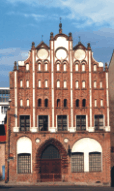 24. Gothic tenement-house (Protzen's House,The Old House) - from
the second half of 15th cent. Rebuilt in 1957 - 59. Today the seat
of The First Grade Public Musical School. Unique rich gable decoration, so-called
Stargard blend. One of the finest, late gothic buildings in Poland.
24. Gothic tenement-house (Protzen's House,The Old House) - from
the second half of 15th cent. Rebuilt in 1957 - 59. Today the seat
of The First Grade Public Musical School. Unique rich gable decoration, so-called
Stargard blend. One of the finest, late gothic buildings in Poland.
25. 'PTTK Hotel - an unique in form building from 1876.
One of the few Old Town's buildings, which survived the destructions in 1945.
In addition to the buildings covered by the map we recommend: monumental,
so-called red barracks from 1881 - 84, at 11 Listopada street, the first
High School building from 1882 (presented by Germans on the World Exhibition
in Chicago) at Staszica street, and the building of the nowadays Town Hall from 1901,
at 17 Czarnieckiego street.